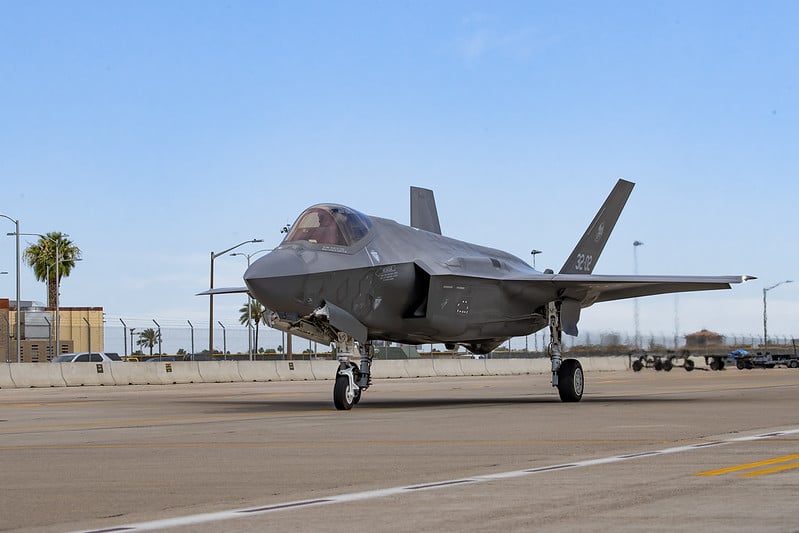Aerospace
Germany Becomes Latest Country to Join the F-35 Team

The German Ministry of Defense announced today it is procuring 35 Lockheed Martin 5th Generation F-35 Lightning II aircraft.
Germany is the ninth foreign military sales country to join the program,” said Lt. Gen. Michael Schmidt, F-35 Program Executive Officer. “We look forward to working with them to deliver the F-35 Air System to meet their national defense requirements.”
Three new F-35 fighter jets land in Israel(Opens in a new browser tab)
The agreement includes a comprehensive package of engines, role-specific mission equipment, spare and replacement parts, technical and logistic support, training and armament.
Lockheed Martin has been a committed partner to the Bundeswehr for more than 50 years, and the F-35 opens another chapter of supporting Germany’s interests for national and European security. By the 2030s, it is expected that over 550 F-35s will work together from more than 10 European countries, including two full U.S. F-35 squadrons at RAF Lakenheath.
Pentagon suspends F-35 deliveries after discovering materials from China(Opens in a new browser tab)
As a cornerstone for interoperability with NATO, the F-35 is the only 5th Generation fighter available today to strengthen Germany’s operational capability with allies. Connectivity has become increasingly more important as the battlespace continues to evolve, and the F-35 is positioned to play a critical role in that change and contribute to 21st Century Security missions.
To date, the F-35 operates from 26 bases worldwide, with nine nations operating F-35s on their home soil. There are more than 875 F-35s in service today, with more than 1,845 pilots and 13,350 maintainers trained on the aircraft.

Aerospace
Boeing Transfers Rocket Stage to NASA, Paving Way for Human Moon Mission

Boeing has achieved a significant milestone by providing NASA with the second core stage of the Space Launch System (SLS) rocket.
This crucial component, crafted at NASA’s Michoud Assembly Facility (MAF), is set to propel the Artemis II crew into lunar orbit, marking humanity’s return to deep space after a 50-year hiatus.
The monumental Boeing-built rocket stage, the largest element of the Artemis II mission, will embark on a journey aboard the Pegasus barge, traveling 900 miles to NASA’s Kennedy Space Center.
Comparison of two legendary aircraft B777x vs B747 aircraft:Click here
Upon arrival, it will be meticulously integrated with other essential Artemis II components, including the upper stage, solid rocket boosters, and NASA’s Orion spacecraft within the iconic Vehicle Assembly Building. This intricate integration process is a vital step toward the eagerly anticipated Artemis II launch, slated for 2025.
“Boeing-built products helped land humankind on the moon in 1969, and we’re proud to continue that legacy through the Artemis generation,” remarked Dave Dutcher, vice president and program manager for Boeing’s SLS program. “Together, with NASA and our industry partners and suppliers, we are building the world’s most capable rocket and paving the way to deep space through America’s rocket factory in New Orleans.”
NASA, Lockheed Martin Reveal X-59 Quiet Supersonic Aircraft:Click here
The delivery of Core Stage 2 marks a significant achievement in the evolution of the SLS rocket. Towering over 200 feet and powered by four RS-25 engines, this core stage, coupled with two solid-fueled booster rockets, will generate a staggering 8.8 million pounds of thrust. This immense power is crucial to launching Artemis II and future missions into the vast expanse of space.
The SLS rocket stands unparalleled in its capability to transport both crew and substantial cargo to the moon and beyond in a single launch. Its extraordinary capacity will facilitate the delivery of human-rated spacecraft, habitats, and scientific missions to destinations including the moon and Mars, ushering in a new era of space exploration.
-

 Travel1 week ago
Travel1 week agoAir India to Expand US Operations with Three New Routes After a Decade
-

 Travel2 weeks ago
Travel2 weeks agoWhy We Should Avoid These Stamps in a Passport
-

 Airlines1 month ago
Airlines1 month agoInvestigations Reveal Fake Chinese Titanium in Boeing and Airbus Jets
-

 Tech4 weeks ago
Tech4 weeks agoChina’s CATL Plans 1,800-Mile Electric Plane Launch by 2027
-

 Airport3 days ago
Airport3 days agoTop 10 Largest Airports in the World by Size
-

 Aerospace4 weeks ago
Aerospace4 weeks agoChina’s Fighter Jets Turn Wings into Autonomous Drones
-

 Airlines4 days ago
Airlines4 days agoAir India Rolls Out A350s for Delhi-New York JFK and Newark Routes
-

 Defence3 weeks ago
Defence3 weeks agoBoeing Enhances Chinook with New Engines and Block II Upgrades at $96 Million







